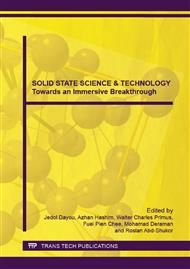[1]
A. Ahmad, M.Y.A. Rahman and M.S. Su'ait Morphological, Infrared, and ionic Conductivity Studies of Poly(ethylene oxide)- 49% poly(methyl methacrylate) grafted natural rubber- Lithium Perchlorate Salt Based Solid Polymer Electrolytes, Journal of Applied Polymer Science, 4222-4229, (2011).
DOI: 10.1002/app.35403
Google Scholar
[2]
K. Murata, An Overview of The Research and Development of Solid Polymer electrolyte batteries, , Elecrrochimico Arm, Vol. 40. No. 13-14. pp.2177-2184, (1995).
DOI: 10.1016/0013-4686(95)00160-g
Google Scholar
[3]
N.A. Stolwijk, M. Wiencierz, C. Heddier, and J. Kosters, What can we learn from ionic measurement in polymer electrolyte? A case study on poly(ethylene oxide)(PEO)- NaI and PEO-LiTFSI , J. Phys. Chem. B Vol. 116, pp.3065-3074, (2012).
DOI: 10.1021/jp2111956
Google Scholar
[4]
X. Qian, N. Gu, Z. Cheng, X. Yang, E. Wang, S. Dong, Plasticizer effect on the ionic conductivity of PEO-based polymer electrolyte, Materials Chemistry and Physics, Vol 74, pp.98-103, (2002).
DOI: 10.1016/s0254-0584(01)00408-4
Google Scholar
[5]
H.M.J.C. Pitawala, M.A.K.L. Dissanayake, V.A. Seneviratne, Combine effect of Al2O3 nano-fillers and EC plasticizer on ionic conductivity enhancement in solid polymer electrolyte (PEO)9LiTF, Solid State Ionics Vol. 178, pp.885-888, (2007).
DOI: 10.1016/j.ssi.2007.04.008
Google Scholar
[6]
M.D. Glasse, R. Idris, R.J. Latham, R.G. Linford and W.S. Schlindwein, Polymer electrolyte based on modified natural rubber, Solid State Ionics, Vol. 147, pp.289-294, (2002).
DOI: 10.1142/9789812791979_0059
Google Scholar
[7]
S.A.M. Noor, A. Ahmad, M.Y.A. Rahman, I.A.T. Talib, Solid Polymeris electrolyte of poly(ethylene) oxide-50% epoxidized natural rubber-lithium triflate (PEO-ENR50-LiCF3SO3), Vol. 2 pp.190-196, (2010).
DOI: 10.4236/ns.2010.23029
Google Scholar
[8]
M.S. Su'ait, A. Ahmad, H. Hamzah, M.Y. A Rahman, Preparation and characterization of PMMA-MG30-LiCLO4 solid polymeric electrolyte, Journal of Physics D: Applied Physics, Vol. 42, (2009).
Google Scholar
[9]
A.M.M. Ali, H. Bahron, R.H.Y. Subban, T.I.T. Kudin, M.Z.A. Yahya, Frequency dependent conductivity studies on PMMA-LiCF3SO3 polymer electrolytes, Materials Research Innovations, Vol. 13, pp.217-219, (2009).
DOI: 10.1179/143307509x440541
Google Scholar
[10]
M.S. Su'ait, A. Ahmad, H. Hamzah, M.Y. A Rahman "Effect of lithium salt concentrations on blended 49% poly(methyhl methacrylate) grafted natural rubber and poly(methyl methacreylate) , Electrochemica Acta, Vol. 57, pp.123-131, (2011).
DOI: 10.1016/j.electacta.2011.06.015
Google Scholar
[11]
A.M.M. Ali, R.H.Y. Subban, H. Bahron, M.Z.A. Yahya, A.S. Kamisan, Investigation on modified natural rubber gel polymer electrolytes for lithium polymer battery, Journal of Power Sources , Vol. 244, pp.636-640, (2013).
DOI: 10.1016/j.jpowsour.2013.01.002
Google Scholar
[12]
K.S. Yap L.P. Teo L.N. Sim S.R. Majid A.K. Arof, Investigation on dielectric relaxation of PMMA-grafted natural rubber incorporated with LiCF3SO3, Physica Vol. B 407, p.2421–2428, (2012).
DOI: 10.1016/j.physb.2012.03.039
Google Scholar
[13]
D. Derouet, P. Intharapat , Q.N. Tran, F. Gohier, C. Nakason, Graft copolymers of natural rubber and poly(dimethyl(acryloyloxymethyl) phosphonate) (NR-g-PDMAMP) or poly(dimethyl(methacryloyloxyethyl) phosphonate) (NR-g-PDMMEP) from photopolymerization in latex medium, European Polymer Journal, Vol. 45 p.820–836, (2009).
DOI: 10.1016/j.eurpolymj.2008.11.044
Google Scholar
[14]
X. Helan Flora, M. Ulaganathan, S. Rajendran, Influence of Lithium salt concentration on PAN-PMMA blend polymer electrolyte, Int. J. Electrochem. Sci., Vol. 7, pp.7451-7462, (2012).
DOI: 10.1016/s1452-3981(23)15796-8
Google Scholar


